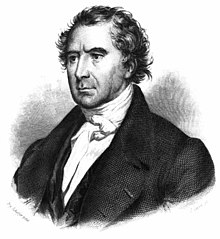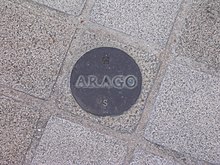François Arago
Dominique François Jean Arago ( Catalan Francesc Joan Domènec Aragó ; born February 26, 1786 in Estagel near Perpignan , † October 2, 1853 in Paris ) was a French astronomer , physicist and politician .
Life
François Aragos father was François Bonaventure Raymond Arago (1754-1814), the mayor of Estagel, a small town about 18 km northwest of Perpignan , and his mother was Marie Anne Agathe Roig (1755-1845). The Arago family came from the eastern Pyrenees. François Arago's parents had eleven children, six boys and five girls. François Aragos brothers were Jean Martin Arago (1788-1836), he fought in the ranks of the rebels during the Mexican War of Independence and had embarked on a military career; Jacques Étienne Victor Arago (1790-1854), a writer and explorer, he took part in an expedition of l'Uranie under the direction of Louis Claude Desaulces de Freycinet (1779-1842) to conduct magnetic and oceanographic studies in the Pacific and Etienne Vincent Arago (1802–1892), writer, playwright and politician, then Victor Arago (1792–1867), Officier de la Légion d'Honneur , Joseph Honoré José Arago (1796–1860). In addition, the sisters Marie Rose Arago (1779–1780), Marie Thérèse Arago (1780–1780), Rose Rosette Arago (1782–1832), Marie Victoire Françoise Arago (1783–1783) and Marguerite Guidette Arago (1798–1859).
François Arago was admitted to the École polytechnique in Paris at the age of seventeen . After his studies, Pierre Simon de Laplace brought him to the Paris observatory . In 1805 he became secretary at the Bureau des Longitudes . On his behalf he carried out the meridian measurements of Pierre Méchain on the meridian of Paris in Spain and on the Balearic Islands from 1806 under great difficulties and dangers during the Spanish uprising against Napoleon together with Jean-Baptiste Biot . He reports about this in his autobiographical notes, The Story of My Youth . In 1808 Arago was arrested on Mallorca because of the lighting of a beacon on a mountain top, which was extremely suspicious at the time, but was able to escape. Biot had already returned to France earlier. Not until 1809 did Arago return to France after another capture and in the same year - 23 years old - was elected a member of the Paris Academy of Sciences and professor of geodesy and analytical geometry at the École polytechnique . He is mentioned in the Mémoires de Physique et de Chimie de la Société d'Arcueil as a member of the Société d'Arcueil .
Arago had with Lucie Carrier Besomes (1788-1829) - both had been married to each other since August 11, 1811 - a total of three sons. For example François Victor Emmanuel Arago (1812-1896), who was active in various political positions during the Second French Republic ( Deuxième République ), such as Minister of Justice. Followed by Alfred Arago (1815–1892) and the youngest son Gabriel Arago (1816–1832).
He found his final resting place in the Paris Père Lachaise cemetery (Division 4).
François Arago and Alexander von Humboldt
In Paris in 1809 , Alexander von Humboldt met François Arago, with whom he soon cultivated a special friendship, both personally and scientifically. Both were interested in the phenomenon of geomagnetism .
Scientific achievements
Based on Thomas Young's double slit experiments on the interference of natural ( unpolarized ) light , Arago and Augustin Jean Fresnel carried out various experiments on the interference of polarized light around 1817. The aim was to gain further knowledge about the nature of the wave character of light (according to the so-called undulation theory ). At the beginning, they assumed that light is a longitudinal wave . However, their results were not compatible with the behavior of longitudinal vibrations. Together with Young, to whom Arago sent the results for discussion, they finally came to the conclusion that light must be two transverse waves oriented perpendicular to one another . Fresnel and Arago summarized their results in four statements on the interference of polarized light, the Fresnel-Arago laws .
Alexis Thérèse Petit (1791–1820) married a sister of Aragos, and together they carried out experiments on the refraction of light and the influence of temperature on the refractive index in gases. Together with this he found in 1816 the law according to which two rays polarized in one plane can interfere with one another, but rays polarized perpendicular to one another cannot.
In 1818 the French Académie des Sciences announced a competition, the jury of which was headed by Arago. The 30-year-old Augustin-Jean Fresnel contributed with a new kind of work on wave optics . After Siméon Denis Poisson had questioned the predictions of the theory with his seemingly absurd thought experiment on the formation of Poisson spots , Arago was able to prove this effect experimentally. In the English-language specialist literature, the stain is therefore also referred to as the Arago spot .
In 1820 he noticed the magnetization of iron (steel needles) by a current-carrying conductor. In 1824 he carried out an experiment in which a freely rotating magnetic needle hovers over a rotating copper disk and is also set in motion by the rotation of the disk. Michael Faraday showed a few years later that this was induction . Arago called this phenomenon rotational magnetism . It was also the first attempt to prove the eddy current .

From 1830 Arago was director of the Paris observatory and used all modern possibilities of astronomy and physics. He was the first to attribute the scintillation of the stars to interferences in the earth's atmosphere that arise from the unrest in the air. In December 1829 he became an honorary member of the Russian Academy of Sciences in Saint Petersburg . In 1832 Arago was elected to the American Academy of Arts and Sciences . From 1835 he was an external member of the Göttingen Academy of Sciences .
On August 19, 1839, Arago officially presented the invention of photography by Louis Daguerre and Joseph Nicéphore Nièpce to the French Academy of Science and the public. Previously, the Chamber of Deputies and the House of Pairs had approved a law according to which the rights to the invention were bought by the French state and given as a gift to the world. Daguerre received a lifelong monthly pension of 6,000 francs and Isidore Nièpce , the son of Joseph Nicéphore Nièpce, received such a pension of 4,000 francs.
Honors
- On May 31, 1842, Arago was accepted as a foreign member of the Prussian order Pour le Mérite for science and the arts .
- Since 1815 he was an Honorary Fellow of the Royal Society of Edinburgh .
- From 1828 he was a foreign member of the Royal Prussian Academy of Sciences .
- In 1843 he was appointed a foreign member of the Bavarian Academy of Sciences .
- In 1850 Cape Arago in Oregon was named after him.
- His name is immortalized on the Eiffel Tower , see: The 72 names on the Eiffel Tower .
- On the Meridian of Paris in 1995, Dutch concept artist Jan Dibbets set bronze Arago medallions into pavement, sidewalks, courtyards and various buildings. Of the original 135 badges, some have been stolen since the publication of Dan Brown's bestseller The Da Vinci Code .
- The Arago glacier in Antarctica, the asteroid (1005) Arago , the lunar crater Arago and a Martian crater were named after him, as were two French cable layers , the François Arago from 1882 and the Arago from 1931 and the submarine Arago from 1913.
Political career
After the July Revolution of 1830 , Arago became involved in politics. As a republican member of the “Pyrénées-Orientales” region, he spoke in the Chamber of Deputies during the July monarchy, in particular on issues relating to shipping, the construction of canals and the railways. After the revolution of 1848 Alphonse de Lamartine brought him into the provisional government as Minister of War and the Navy. Together with his undersecretary Victor Schoelcher, he played a decisive role in the final abolition of slavery in France. For a month and a half he was chairman of the Executive Commission of the Republic before the assembly put General Louis-Eugène Cavaignac at the head of power. He refused to join Napoleon III. to join after his coup d'état in 1851, and resigned from his public offices.

Works
- Conversations from the field of natural history . Hoffmann, Stuttgart 1837–1844 (6 volumes). Digitized
- Popular lectures on astronomy, with 38 lithographed Fig. Voigt, Weimar 1838. Digitized
- Dominique Arago: Œuvres complètes. Baudry / Gide, Paris 1854–1862, 17 vols., Ed. v. JA Barral, German in 16 volumes, Leipzig 1854–1860.
- Article by / about Arago, François in the Polytechnic Journal
literature
- JZ Buchwald : The battle between Arago and Biot over Fresnel. In: Journal of Optics. 20 1989, pp. 109-117.
- Maurice Daumas: Arago, 1786-1853. Belin, Paris 1987, ISBN 2-7011-1122-6 .
- François Sarda: Les Arago. François et les autres. Tallandier, Paris 2002, ISBN 2-84734-005-X . (with a foreword by Emmanuel Le Roy Ladurie )
- James Lequeux: Francois Arago, uns avant généraux , EDP Sciences 2008
- English edition: François Arago: A 19th Century French Humanist and Pioneer in Astrophysics , Springer 2016
Web links
- A death wreath . In: The Gazebo . 1854, p. 15-17 ( full text [ Wikisource ]).
- Edited letters from and to François Arago in the web service correspSearch of the BBAW
- Freiklick.at: Dominique François Jean Arago - The Open Source Father
- Adolf Wüllner: Refraction exponents of gases. Law of Arago and Biot. In: Textbook of Experimental Physics. Volume 1. Part 2, p. 722 ( limited preview in Google Book search).
- In the Footsteps of Arago. Retrieved January 5, 2016 .
Individual evidence
- ↑ Family genealogy
- ↑ siblings
- ↑ Family genealogy
- ^ Dennis H. Goldstein: Polarized Light, Revised and Expanded . 2nd Edition. CRC Press, 2011, ISBN 978-0-203-91158-7 , pp. xiii ( limited preview in Google Book Search).
- ^ Foreign members of the Russian Academy of Sciences since 1724: Arago, Dominique François Jean. Russian Academy of Sciences, accessed November 29, 2019 (Russian).
- ↑ Holger Krahnke: The members of the Academy of Sciences in Göttingen 1751-2001 (= Treatises of the Academy of Sciences in Göttingen, Philological-Historical Class. Volume 3, Vol. 246 = Treatises of the Academy of Sciences in Göttingen, Mathematical-Physical Class. Episode 3, vol. 50). Vandenhoeck & Ruprecht, Göttingen 2001, ISBN 3-525-82516-1 , p. 27.
- ^ Newhall, Beaumont: History of Photography . Schirmer / Mosel, Munich 1998, ISBN 3-88814-319-5 , p. 24-25 .
- ^ Orden Pour le Mérite for sciences and arts (ed.): The members of the order . tape 1: 1842-1881 . Gebr. Mann Verlag, Berlin 1975, ISBN 3-7861-6189-5 ( orden-pourlemerite.de [PDF; 19.4 MB ; accessed on September 18, 2011]).
- ↑ shaper RSE Fellows 1783-2002. (PDF) Royal Society of Edinburgh, accessed October 6, 2019 .
- ^ Members of the previous academies. Dominique-François-Jean Arago. Berlin-Brandenburg Academy of Sciences and Humanities , accessed on February 16, 2015 .
| predecessor | Office | successor |
|---|---|---|
| Louis-Eugène Cavaignac |
Minister of War of France April 5, 1848–11. May 1848 |
Jean-Baptiste Adolphe Charras |
| personal data | |
|---|---|
| SURNAME | Arago, François |
| ALTERNATIVE NAMES | Arago, Dominique François Jean (full name); Aragó, Francesc Joan Domènec (Catalan) |
| BRIEF DESCRIPTION | French astronomer, physicist and politician |
| DATE OF BIRTH | February 26, 1786 |
| PLACE OF BIRTH | Estagel near Perpignan |
| DATE OF DEATH | October 2, 1853 |
| Place of death | Paris |



